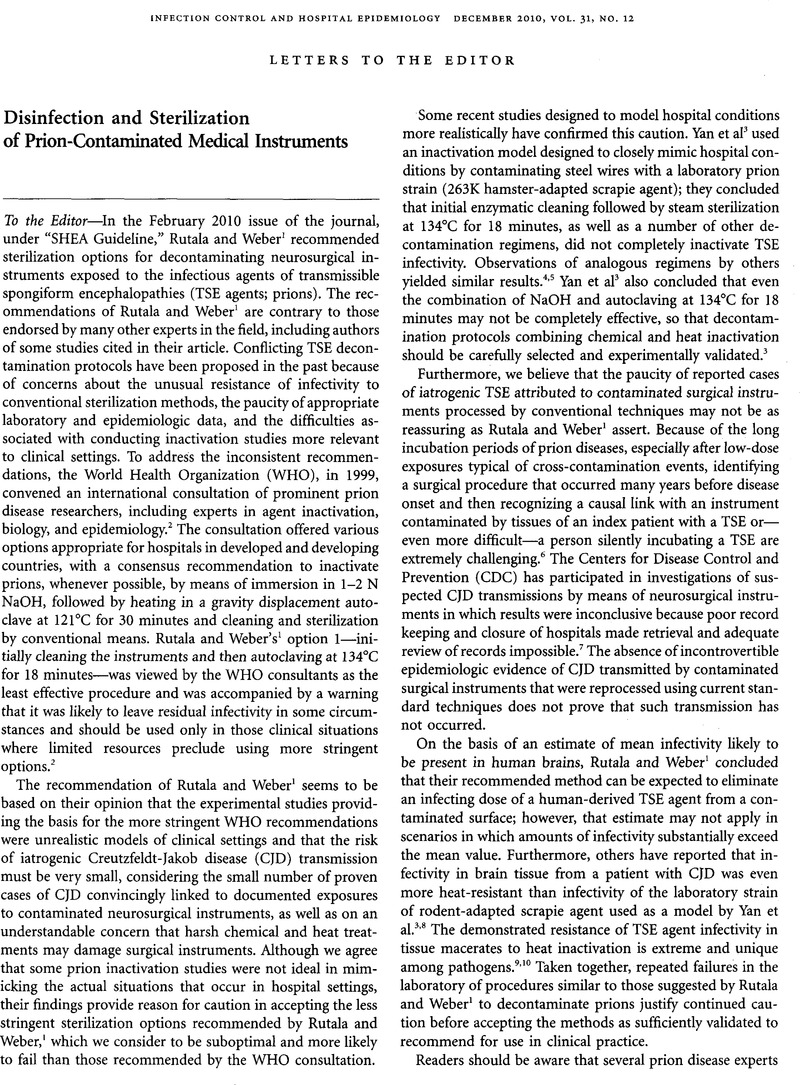Crossref Citations
This article has been cited by the following publications. This list is generated based on data provided by Crossref.
Rutala, William A.
and
Weber, David J.
2010.
Reply to Belay et al.
Infection Control & Hospital Epidemiology,
Vol. 31,
Issue. 12,
p.
1306.
López‐Niño, Javier
García‐Caballero, Lucía
González‐Mosquera, Antonio
Seoane‐Romero, Juan
Varela‐Centelles, Pablo
and
Seoane, Juan
2012.
Lamb Ex Vivo Model for Training in Maxillary Sinus Floor Elevation Surgery: A Comparative Study With Human Standards.
Journal of Periodontology,
Vol. 83,
Issue. 3,
p.
354.
Sehulster, L.M.
2012.
Sterilisation of Biomaterials and Medical Devices.
p.
261.
Belay, Ermias D.
Blase, Jennifer
Sehulster, Lynne M.
Maddox, Ryan A.
and
Schonberger, Lawrence B.
2013.
Management of Neurosurgical Instruments and Patients Exposed to Creutzfeldt-Jakob Disease.
Infection Control & Hospital Epidemiology,
Vol. 34,
Issue. 12,
p.
1272.
Rutala, William A.
and
Weber, David J.
2015.
Mandell, Douglas, and Bennett's Principles and Practice of Infectious Diseases.
p.
3294.
2016.
Clinical Microbiology Procedures Handbook.
p.
15.5.1.1.
Asher, David M.
and
Gregori, Luisa
2018.
Human Prion Diseases.
Vol. 153,
Issue. ,
p.
1.
Rutala, William A.
and
Weber, David J.
2021.
Disinfection and Sterilization in Health Care Facilities.
Infectious Disease Clinics of North America,
Vol. 35,
Issue. 3,
p.
575.
Pritzkow, Sandra
Gorski, Damian
Ramirez, Frank
and
Soto, Claudio
2021.
Prion Dissemination through the Environment and Medical Practices: Facts and Risks for Human Health.
Clinical Microbiology Reviews,
Vol. 34,
Issue. 4,
Wang, Fei
Pritzkow, Sandra
and
Soto, Claudio
2023.
PMCA for ultrasensitive detection of prions and to study disease biology.
Cell and Tissue Research,
Vol. 392,
Issue. 1,
p.
307.
Simons, Corrie C.
and
Capraro, Gerald A.
2023.
ClinMicroNow.
p.
1.
Schoberleitner, Ines
Faserl, Klaus
Lackner, Michaela
Coraça-Huber, Débora C.
Augustin, Angela
Imsirovic, Anja
Sigl, Stephan
and
Wolfram, Dolores
2024.
Unraveling the Immune Web: Advances in SMI Capsular Fibrosis from Molecular Insights to Preclinical Breakthroughs.
Biomolecules,
Vol. 14,
Issue. 11,
p.
1433.
Schoberleitner, Ines
Lackner, Michaela
Coraça-Huber, Débora C.
Augustin, Angela
Imsirovic, Anja
Sigl, Stephan
and
Wolfram, Dolores
2024.
SMI-Capsular Fibrosis and Biofilm Dynamics: Molecular Mechanisms, Clinical Implications, and Antimicrobial Approaches.
International Journal of Molecular Sciences,
Vol. 25,
Issue. 21,
p.
11675.
Schoberleitner, Ines
Baier, Leoni
Lackner, Michaela
Zenz, Lisa-Maria
Coraça-Huber, Débora C.
Ullmer, Wendy
Damerum, Annabelle
Faserl, Klaus
Sigl, Stephan
Steinkellner, Theresia
Winkelmann, Selina
Sarg, Bettina
Egle, Daniel
Brunner, Christine
and
Wolfram, Dolores
2024.
Surface Topography, Microbial Adhesion, and Immune Responses in Silicone Mammary Implant-Associated Capsular Fibrosis.
International Journal of Molecular Sciences,
Vol. 25,
Issue. 6,
p.
3163.



